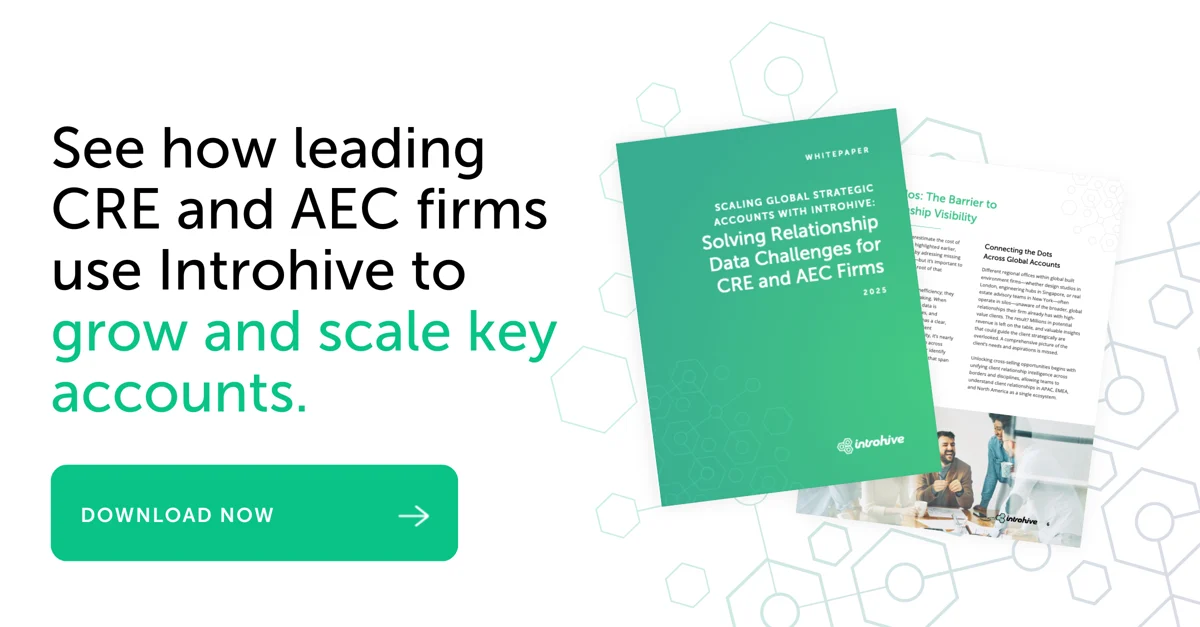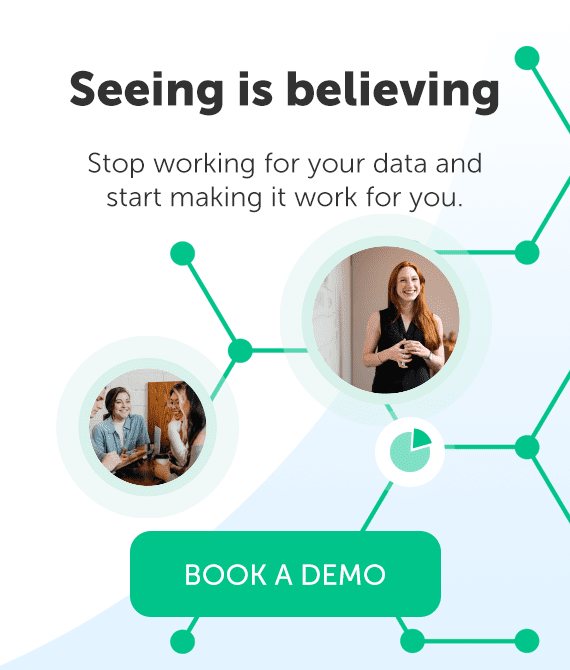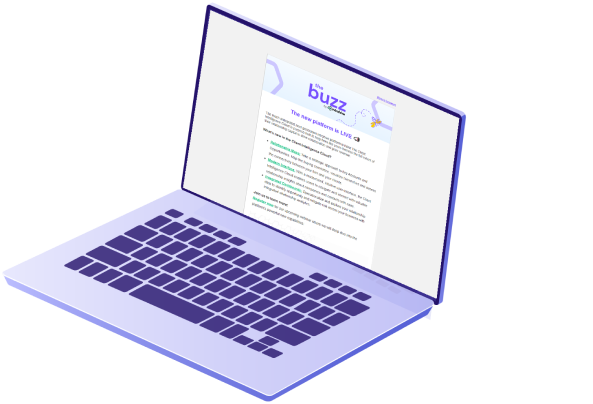Laing O’Rourke and Introhive
Laing O’Rourke’s journey with Introhive began as part of a broader CRM transformation, led in partnership with Credera (formerly BrightGen). Following their migration to Salesforce Lightning to centralise and modernise client data, the team identified a need for deeper relationship intelligence, especially important in the construction environment where long-term engagement and personal connection are critical.
Over time, Introhive has become integral to how Laing O’Rourke manages stakeholder visibility, supports strategic bids, and fosters consistent engagement across the project lifecycle. Today, it serves as a trusted extension of their data strategy and a key enabler of relationship-led growth.
Learn more about the three-way partnership with Credera, Salesforce, and Introhive.
Want to save or share this case study?
About Laing O’Rourke
Laing O’Rourke is a multinational engineering and construction company delivering major infrastructure and building projects across the UK, Australia, and beyond. Known for its commitment to innovation, digital transformation, and client-centric delivery, Laing O’Rourke operates at the intersection of technical excellence and long-term partnership. With projects spanning sectors such as healthcare, energy, transportation, and defence, the company is focused on building smarter, safer, and more sustainable solutions for the built environment.
Opportunity
Fragmented data and siloed relationships
Before transitioning to Salesforce Lightning, Laing O’Rourke’s client data environment was highly fragmented and heavily dependent upon manual processes and relationship data between their construction directors, work winning teams, and client organisations, resulting in data that remained siloed within individual teams. Information was dispersed across personal assistants and individual director diaries, paper-based records, and spreadsheets, making it difficult to establish a single source of truth. When a CRM was first introduced in 2009, much of the contact data remained offline and was not captured through Outlook by default. This meant they had to ask an individual who in the client base would be most appropriate to answer a question or help with something, rather than being able to simply look it up.
The need for strategic relationship management
Before implementing a more data-driven approach, Laing O’Rourke relied heavily on human knowledge to navigate client relationships, a method that, while valuable, lacked scalability and consistency. There was no reliable way to track or verify who within the business had meaningful connections with key client stakeholders.
“You need to build trust before you build buildings,” Natalie Petty explained, highlighting the central role that relationships play in securing and delivering major projects. However, without a system to back up that relational insight, the business risked missing opportunities or misaligning its engagement efforts.
Introhive marked a turning point in that it gave Laing O’Rourke the ability to combine human insight with clean, evidence-based data.
“We’re not trying to replace that human knowledge or those known relationships,” Petty noted. “But we want to make sure it’s really solidified with data and evidence.”
This shift meant Laing O’Rourke could finally take a more strategic approach to relationship management. With better visibility into existing networks across the organization, teams were able to more effectively target and elevate key strategic relationships, something that simply wasn’t possible before.
Decision-making process
Modernising with Salesforce Lightning and Credera
The move to Salesforce Lightning marked a pivotal shift in Laing O’Rourke’s digital transformation. The partnership with Credera brought structure to a previously manual and fragmented CRM environment and introduced governance frameworks, adoption strategies, and standardised processes that helped lay the groundwork for a scalable system. While Salesforce delivered the centralised platform they needed, it also highlighted the need for a complementary solution that could capture relationship data automatically and enrich the human connections at the heart of their work.
Solution
Introducing Introhive for passive relationship intelligence
Introhive was brought in to fill that automation gap. The platform passively captures and updates relationship data, an essential feature for a workforce that isn’t always connected to digital systems in real time and instead relies primarily on their phones. “At their point of need, it will tell them the truth,” said Natalie. This passive data ingestion became foundational for more informed and timely client interactions.
Personalised client engagement
The ability to reference specific colleagues and shared histories during client conversations, even if a team member wasn’t involved in the current project, has proven invaluable. Introhive surfaces these connections, enabling team members to reference colleagues by name, making clients feel recognised, informed, and genuinely connected.
Targeting the right people for high-impact events and announcements
Laing O’Rourke uses Introhive to support smaller strategic events, such as a dinner, a sporting event, or key announcements by helping quickly identify the right individuals to invite or determine, for example, their current top 10 clients for targeted communications.
Previously, PAs and administrators often relied on outdated guest lists from past events, especially for recurring gatherings. But as client structures evolved and data aged, that approach became less reliable. Today, Introhive provides up-to-date relationship and contact data, making it easier for teams to answer common leadership questions like: Who are our top 10 clients for this announcement? or, Who should we invite to this dinner?
While Laing O’Rourke still maintains some tagging of clients within Salesforce, that process has become more flexible over time. Rather than relying solely on predefined categories, teams now use a combination of Introhive data and business context to guide outreach for more informed, timely engagement.
Results
Strategic bidding and client visibility
Laing O’Rourke’s work-winning cycle often begins years before a formal tender, with long-term relationship nurturing playing a critical role. When it comes time to bid, often within a tight six to twelve week window, Introhive helps bid leaders quickly understand who within the organisation has the strongest existing relationships with the client. This allows them to tailor their approach based on real, historical engagement data.
The automated capture of contact and activity data means teams spend less time manually inputting information and more time on high-value conversations. Bid leaders have found this especially powerful when trying to determine how long Laing O’Rourke has been connected to a client, helping guide strategy during competitive tender processes.
Crucially, the shared intelligence extends beyond the bid. Relationship data captured in Introhive supports alignment across the entire project lifecycle, with client engagement running as a continuous thread from initial pursuit through to delivery and handover. This approach ensures consistent communication, smooth handovers, and reduced duplication of effort. Combined with Salesforce metrics like win rate (“strike rate”), these insights help Laing O’Rourke identify patterns in successful bids and uncover cross-selling opportunities, reinforcing a culture of transparency, adaptability, and continuous improvement.
“Day in the life” use cases
Introhive fits naturally into the workflow. Staff use it to prep for meetings, validate contacts, or follow up after conversations. The Outlook panel is particularly appreciated for providing insights passively, without requiring users to search manually. As Natalie described, “You haven’t got to go and filter your own Outlook… it just tells you.”
Measuring impact through relationships and efficiency
At Laing O’Rourke, success with Introhive isn’t measured by direct revenue attribution, but by improvements in relationship health, CRM adoption, and operational efficiency. Key indicators include relationship strength, frequency of client engagement, contact creation, and reductions in business development cycle time. “It’s not about selling a product, it’s about building trust over time,” Natalie Petty emphasised.
That trust-building is already delivering value. In one major hospital project, stakeholder mapping revealed underutilised internal contacts with existing client relationships. Leveraging those connections enabled stronger early-stage engagement and has demonstrated how relationship intelligence can drive more strategic, data-informed decisions across complex bids.
What’s next for Laing O’Rourke
Embedding relationship intelligence in project delivery
As Laing O’Rourke pursues more complex, long-term initiatives like hospital builds and energy infrastructure, they’re working to embed Introhive’s capabilities into the delivery phase.
A key development in this area is the planned introduction of Contact Roles within Salesforce, an idea that emerged through their collaboration with Introhive. By capturing and linking individual client contacts to specific construction projects (represented as opportunities in Salesforce), Laing O’Rourke aims to bridge a long-standing gap: the ability to see exactly who they engaged with on each project, at every stage of the delivery lifecycle.
This new capability will help answer important questions like: Which client stakeholders were involved in each project? Are we building relationships with the right people at each organisation? Are we engaging consistently across different projects with the same client organisation?
Rather than assuming that a single project’s success translates to broader client sentiment, Laing O’Rourke can now focus on understanding exactly who they engaged with on each project, why those relationships worked, and how to build on them for future opportunities.
Prioritising consistency in a changing environment
As Laing O’Rourke continues to evolve, there’s a growing focus on sustaining the practices that are working well. As a result, the organisation is investing in consistency to ensure that teams, both established and new, share a unified approach to client engagement. The goal is to create a culture of consistency and shared understanding, one that ensures clients experience Laing O’Rourke as a unified, informed, and human-centric partner.
Ready to transform your client engagement?
See how relationship intelligence can work for you.



